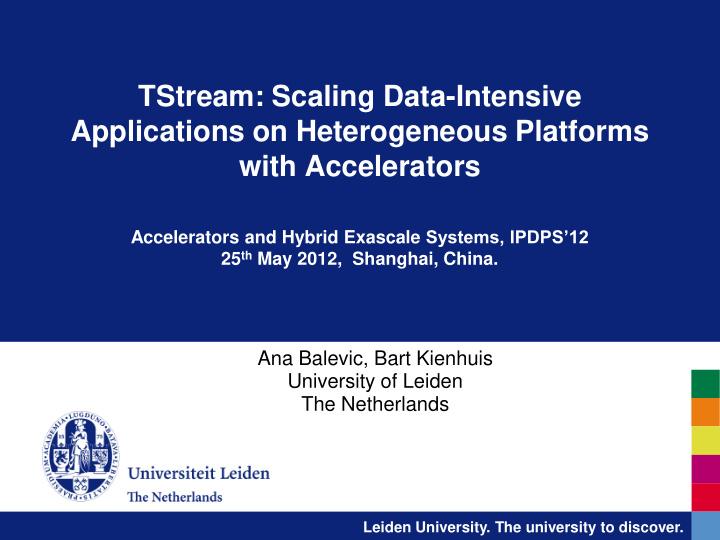



TStream: Scaling Data-Intensive Applications on Heterogeneous Platforms with Accelerators Accelerators and Hybrid Exascale Systems, IPDPS’12 25 th May 2012, Shanghai, China. Ana Balevic, Bart Kienhuis University of Leiden The Netherlands Leiden University. The university to discover.
Motivation: Acceleration of Data-Intensive Applications on Heterogeneous Platforms with GPUs - Tremendous compute power delivered by graphics cards Applications, e.g. bioinformatics: Big data Architectures: multiple devices, heterogeneity - Heterogeneous X*CPUs + Y*GPUs Platforms - Embedded: TI’s OMAP ( ARM+special coproc), NVIDIA Tegra - HPC: Lomonosov@1.3petaflops (1554x GPU+4-core CPUs) Leiden University. The university to discover.
Parallelization Approaches Obtaining a Parallel Program: Explicit Parallel Semi-Automatic (Languages, Automatic Programming Directive-Based Parallelization) Parallelization Transformation frameworks POSIX Intel’s OpenMP Classical Compiler Analysis: Threads data parallelism – CETUS, PGI TBB OpenACC Polyhedral Model: CUDA data parallelism SM (LooPo, Pluto, PoCC, OpenCL memory CAPS/HMPP ROSE, SUIF, CHiLL) model V V our research DM CPU GPU +run-time environments OpenMP, TBB, StarSS, mem mem task + pipeline parallelism StarPU Compaan/PNgen Leiden University. The university to discover.
Polyhedral Model: Introduction - Static Affine Nested Loop Programs (SANLPs) Loop bounds, control predicates, array references – affine functions in - loop indices and global parameters - Host spots - streaming multimedia and signal processing applications - Polyhedral model of a SANLP can be automatically derived based on Featurier’s fundamental work on array dataflow analysis (see: PoCC, PN, Compaan) - Parallelizing/optimizing transforms on the polyhedral model, then target- specific code generation (C, SystemC, VHDL, Phtreads, CUDA/OpenCL) Leiden University. The university to discover.
Polyhedral State of The Art - State of the art polyhedral frameworks (HPC): - PLuTo, CHiLL: • Polyhedral Model -> Coarse Grain Parallelism • Bondhugula et al.,“PLuTo:a practical and fully automatic polyhedral program optimization system,” (PLDI’08) • Baskaran et al, “Automatic C -to-CUDA code generation for affine programs”, (CC’09) - Single device (CPU or GPU) , shared memory model - Assumptions - working data set: - (1) resides in device memory - (2) always fits in device memory » Offloading? » Big data? » Efficient Communication? Leiden University. The university to discover.
Solution Approach - Extension of polyhedral parallelization – compiler techniques for data partitioning into I/O tiles - Staging I/O tiles for transfers by asynchronous entities, e.g. helper threads - Buffered communication and streaming to GPU Leiden University. The university to discover.
Tiling + Streaming = TStream - Stage I: Compiler transforms for data partitioning - Tiling in polyhedral model - I/O tile bounds + footprint computation - Stage II: Support for tile streaming - Communication/execution mapping + tile staging - Efficient stream buffer design Leiden University. The university to discover.
I/O Tiling 1/2 - Tiling / multi-dimensional strip-mining - Decompose outer loop nest(s) into two loops • Tile-loop Multi-dimensional iteration domain (here: • Point-loop 2-dim index vector w. supernode - Interchange iterators) Tile domain – extension of Ds with additional conditions: - Coarse-grain parallelism, e.g. outter loop -> omp parallel for I/O Tiling – 1 st top-level tiling: Partitioning of the computation - domain & Splitting working data set into smaller blocks Leiden University. The university to discover.
I/O Tiling 2/2 - Conditions for GPU Execution - All data elements must fit into the memory of the accelerator - Host-accelerator transfer management - Working data set computation - I/O Tiling repeated until tile footprint is small enough to fit into GPU memory Leiden University. The university to discover.
Tile Footprint Example for ( i = 0; i<N; i++ ) for ( j = 0; j<N; j++ ) - R Leiden University. The university to discover.
TStream: - Stage I: Transforms for data splitting - Tiling in polyhedral model - I/O tile bounds + footprint computation - Stage II: Support for tile streaming - Mapping for execution, tile staging - Efficient stream buffer design Leiden University. The university to discover.
Platform Mapping - Asynchronous producer-transformer- consumer processes, implemented by helper threads executing on CPU and GPU - Transformer process (GPU) executes (automatically) parallelized version of computation domain, e.g. CUDA/OpenCL on GPU - Producer (CPU) and consumer (CPU) processes stage I/O tile DMA transfers: tile “lifting” + placement onto bus/buff Leiden University. The university to discover.
Efficient Stream Buffer Design for Heterogeneous Producer/Consumer Pairs GPU-T CPU-P CPU-C c) GPU Transformer Thread for (fid = 0; fid <N; fid++) { //pop token from QA wait(buffQA->fullSlots); wait(buffQC->emptySlots); b) CPU Producer Thread d) Stream Buffer (FIFO) stream[QA] inTokenQA = buffQA->getRdPtr(); h_data d_data outTokenQC = buffQC->getWrPtr(); for (fid=0; fid<N; fid++){ async mem transf. //push token in QA transformerKernel<<<NB, NT, NM, rdptr wait(buffQA- computeStream>>> >emptySlots); (inTokenQA, outTokenQC); memcpyH2D //produce/load wrptr buffQA->incRdPtr(); token[fid] buffQC->incWrPtr(); token[fid]= … signal(buffQA->emptySlots); host mem device mem buffQA (pinned) (GPU GM) buffQA->put(token[fid]); //init token push in QC } buffQC->put(token[fid]); e) AsyncQHandler CPU } waitAsyncWriteToComplete (…); signal(buff->fullSlots); GPU Stream Buffer • Circular buffer w. double buffering • Pinned host + device memory • CUDA Streams + events combined with CPU- DFM/PACT’11 side sync. mechanisms Leiden University. The university to discover.
Preliminary Results - Proof of concept: POSIX Threads + CUDA 4.0 (streams) - Experimental Setup - AMD Phenom II X49653.4GHz CPU - ASUS M4A785TD- VEVO MB, PCIExpress 2.0 x16 - Tesla C2050GPU (2-way DMA overlap) - Microbenchmarks Leiden University. The university to discover.
Preliminary Results – Data Patterns Vop (1:1, aligned) Vadd ( 2:1, aligned) Sobel (1*:1, non-aligned) NVVP Leiden University. The university to discover.
Conclusions TStream – a two phase approach for scaling data intensive applications - - Compile-time transforms • I/O Tiling - Stand-alone or additional level of tiling in existing polyhedral frameworks • Mapping of tile access and communication code - Run-time support: • Tile streaming model - Asynchronous execution and efficient stream buffer design - Large data processing on accelerators feasible from polyhedral model - Enables overlapping of host-accelerator communication and computation - First results promising, future work: integration with polyhedral process network model and the Compaan compiler framework, application studies, multi-GPU support - Thanks to Compaan Design and NVIDIA for their support! Leiden University. The university to discover.
Recommend
More recommend